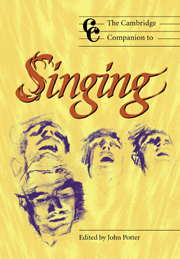Book contents
- Frontmatter
- 1 Introduction: singing at the turn of the century
- Part I Popular traditions
- 2 ‘Songlines’: vocal traditions in world music
- 3 Rock singing
- 4 The evolving language of rap
- 5 Jazz singing: the first hundred years
- Part II The voice in the theatre
- Part III Choral music and song
- Part IV Performance practices
- Notes
- Select bibliography
- Index
3 - Rock singing
from Part I - Popular traditions
Published online by Cambridge University Press: 28 September 2011
- Frontmatter
- 1 Introduction: singing at the turn of the century
- Part I Popular traditions
- 2 ‘Songlines’: vocal traditions in world music
- 3 Rock singing
- 4 The evolving language of rap
- 5 Jazz singing: the first hundred years
- Part II The voice in the theatre
- Part III Choral music and song
- Part IV Performance practices
- Notes
- Select bibliography
- Index
Summary
Types of singing
He hunches into the microphone and croons, growls and then screams from the pit of his stomach. … As Cobain circles round the lyrical repetitions, his voice becomes more and more racked … and he pushes the words so hard it's as though he's trying to vomit them out.
Rock singing – as in this description of Nirvana lead singer, Kurt Cobain – is typically thought of in terms of its extreme emotive and dramatic qualities, its physical presence, its originary authenticity, at times so insistent as to occasion pain. It is, so to speak, a natural expression – by comparison (implicit or explicit) with the trained, disciplined technique, the pure tone, the objectifying control associated with classical singing. It is certainly true that in much rock singing the absence of low-larynx technique and of diaphragm-orientated breath-control lead to relatively speech-like voice production; that individuality of voice quality tends to be at a premium; and that the resulting directness of utterance is often taken to be a mark of expressive truth. This flouting of the rules of ‘good singing’ lies at the root of many responses to rock – both approving (it is breaking the rules that makes emotional authenticity possible) and dismissive (breaking the rules proves incompetence, indiscipline and even immorality). Nevertheless, it does not take a great deal of acquaintance with the rock repertoire to suggest that this picture of rock singing is over-simple.
- Type
- Chapter
- Information
- The Cambridge Companion to Singing , pp. 28 - 41Publisher: Cambridge University PressPrint publication year: 2000
- 33
- Cited by

